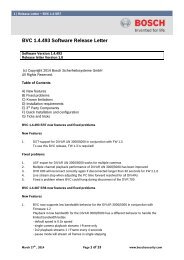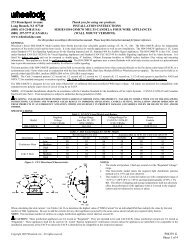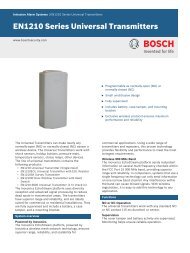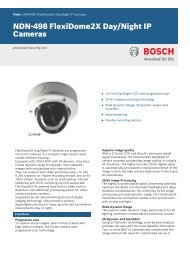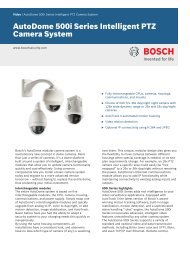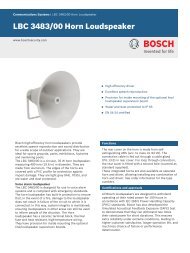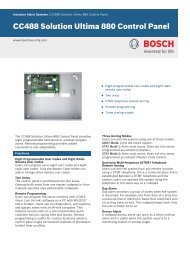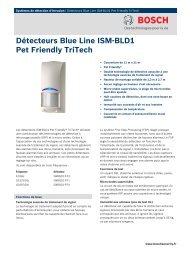VRM Video Recording Manager - Bosch Security Systems
VRM Video Recording Manager - Bosch Security Systems
VRM Video Recording Manager - Bosch Security Systems
You also want an ePaper? Increase the reach of your titles
YUMPU automatically turns print PDFs into web optimized ePapers that Google loves.
22 en | User interface <strong>VRM</strong> <strong>Video</strong> <strong>Recording</strong> <strong>Manager</strong><br />
System-wide CHAP password<br />
Enter the password that you have configured in the iSCSI storage device. The CHAP password<br />
is valid for the <strong>VRM</strong> and is sent to all devices automatically. Replay clients do not need<br />
additional configuration.<br />
Use as failover server / Master server IP address / Password<br />
You can set up a computer as the master server, provided that <strong>VRM</strong> Server is started on it, and<br />
set up another computer as a failover server. The configuration settings of the master server<br />
are then synchronized on the failover server. If the master server fails, the failover server<br />
automatically takes over the management of the <strong>VRM</strong> system.<br />
Secondary target block allocation [GB]<br />
Enter the number of 1 GB storage blocks that are allocated to a device on the failover iSCSI<br />
target (secondary target). The minimum number of blocks for each device allocated to the<br />
secondary target is eight. When carrying out this step, note that each VIP X1600 module is<br />
counted as an individual device.<br />
The retention time configured in the system also applies to secondary target blocks.<br />
The number of secondary target blocks for a device should be selected in such a way that<br />
there is enough disk space to continue recording for the required length of time if the primary<br />
target fails. Depending on the bit rate, you can assume that one block is sufficient for<br />
approximately one hour of recording.<br />
Blocks should remain free on the secondary target as a buffer. These are used by the <strong>VRM</strong><br />
system if the blocks allocated to a device are insufficient.<br />
Calculation example:<br />
– Storage capacity of the failover iSCSI target: 5024 GB<br />
– Number of allocated VIP X1600 devices: 140 (each occupied with four modules)<br />
– Failover block allocation: 8 (minimum)<br />
– Resulting number of allocated failover blocks:<br />
140 x 4 x 8 = 4480<br />
– Resulting number of free failover blocks:<br />
5024 - 4480 = 544<br />
A buffer of 544 GB remains for recordings in case of a failover; this buffer is also available<br />
to the allocated devices if required.<br />
Block reservation for <strong>VRM</strong> Server downtime (days)<br />
Enter the number of days that the assigned encoders will be recorded although the<br />
<strong>VRM</strong> Server is down.<br />
For example, if you set 4, the encoders will be recorded during approximately 4 days of<br />
<strong>VRM</strong> Server downtime.<br />
If your system has encoders with low bit rate, you can significantly reduce the pre-allocated<br />
disk space.<br />
<strong>Recording</strong> preferences mode<br />
Automatic: Load balancing is configured automatically. Each encoder is automatically<br />
assigned 2 iSCSI targets and blocks on these 2 iSCSI targets are assigned to the encoder.<br />
Manual: You can configure load balancing manually in the traditional recording mode.<br />
Section 11.11 <strong>Recording</strong> Preferences tab, page 28<br />
Sanity check period (days)<br />
Move the slider to configure the required time period. After this time period the iSCSI target<br />
is checked and blocks are reassigned if needed.<br />
DOC | V.2.21 | 2011.12 Operator's Manual <strong>Bosch</strong> Sicherheitssysteme GmbH



